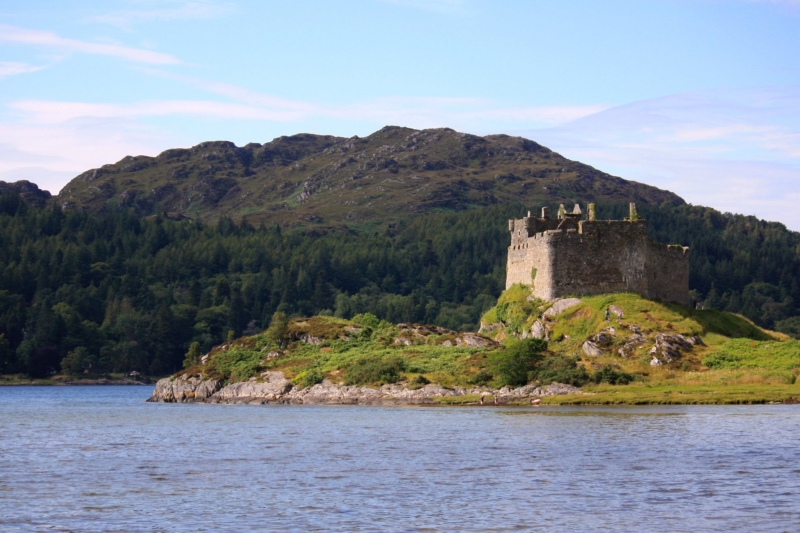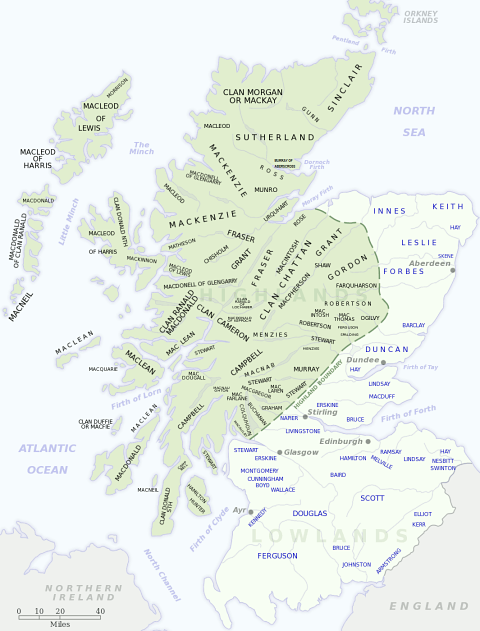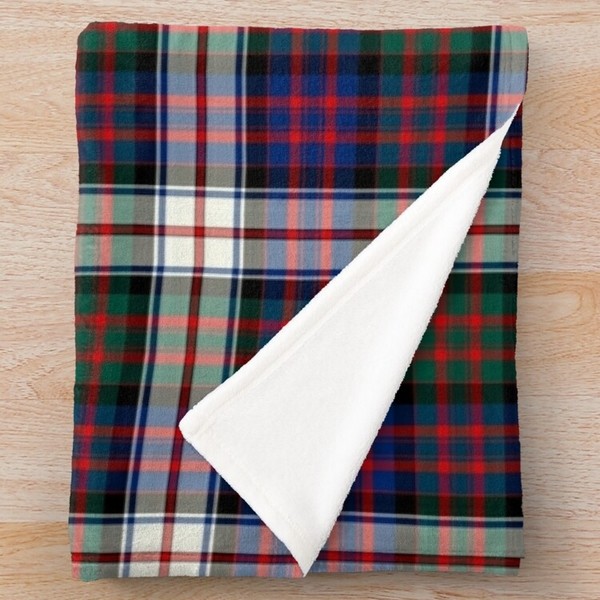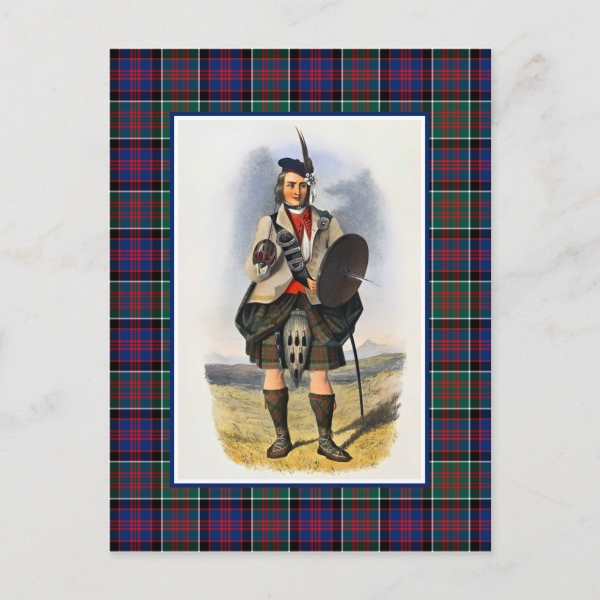
Motto: My hope is constant in thee
Historic Seat: Castle Tioram
District: Hebrides, Lochaber
Associated Surnames: MacEachan, MacGeachie, MacGeachin, MacKechnie, MacKeochan, MacKessock, MacKichan, MacKissock, MacMurrich, MarVurich, MacVurie, Ranald, Ronald
Associated Tartans:
Early MacDonald of Clanranald Genealogy and History:
(Excerpt from "The Scottish Clans and Their Tartans", James Grant, 1906)
By his marriage with Amy de Insulis1, John, Lord of the Isles, left three sons," says Robertson; "but the youngest alone, named Ranald, left issue. From him descend the Clan Ranald, and called of Glengarry and Clanranald. For the latter there is a bar to the chieftainship, the ancestor of the family having been illegitimate." His authority for this assertion is "The Record of the Privy Seal" in 1531. In 1543 a feud ensued between the Frasers and the Clanranald of Moydart in consequence of the following circumstances:
Dougal, chief of Clanranald, made himself so odious by cruelties that the tribe slew him; and then, by election, the command of the clan and lands was given to Alister Alanson, his uncle, to the exclusion of his sons, who were then young. Alister died in 1530, when his natural son, John of Moydart, was acknowledged as chief, but for turbulence was lodged in prison by James IV. The Frasers now attempted to reduce the rights he had acquired in favour of Ranald Galda, or The Stranger, so called from his being fostered by the Frasers. He was the son of Alan M'Ruari, chief of Clanranald, 1481-1509. Alister Alanson was son of a first marriage. This brought about the battle of Blairleine2 in 1544, so called from the combatants letting slip their kilts and fighting in their shirts. Young Ranald was slain, and John of Moydart became eventually the firm friend of Lovat. He died in 1584.
His son Alan married a daughter of MacLeod of Harris, according to Burke, and died in 1593. Alan's son Sir Donald, who was knighted by James VI, waged a fierce war with the Lairds of Duart and Kintail, and died in 1619.
The MacVurichs were the hereditary Sennachies to Clanranald. Murdoch Albanach (i.e., of Scotland) was the first of them, and they kept the Leabhar Dearg, or Red Book of Clanranald.3
Sir Donald's son, John of Clanranald, served in the wars of Montrose in 1644, and in the march to Argyll penetrated as far as Lochcreran, and, according to the Red Book, put about 900 men to death, a tale of slaughter which no other historian, even the vindictive Baillie, corroborates. He died, in old age, at Uist, in 1670. He was succeeded by his son John, who had served with him under Montrose; and in 1650 he appears as one of the "Colonells of the clans in the Isles and Heighlands." He died in 1686.
His son Alan adhered to James VIII, and was killed at Sheriffmuir4. He had married in France, Penelope, daughter of Colonel MacKenzie, Governor of Tangiers, and having no issue, was succeeded by his brother Donald, who died in 1730. Ranald, son of the latter, born in 1692, succeeded and was killed with Wolfe at Quebec, 1759.
Ranald succeeded. In his youth he had been "out" with the Prince in the 1745-46 with his clan, the fighting strength of which was 700. Among them was Neil MacEachin of the Uist branch of the clan, father Stephen James MacDonald, Duke of Tarentum, the truest adherent the great Napoleon ever had. Ranald for a time was A.D.C.5 to Marshal Saxe in his exile after Culloden1. By his second wife, Flora, daughter of MacKinnon of that Ilk, he had several children, and was succeeded by his son John, born in 1764, a Captain in the 22nd Dragoons. He died at Edinburgh in 1794, and was succeeded by his son, Reginald George MacDonald, eighteenth chief, who died in 1873.
This long line of gallant and warlike chiefs is now represented by Allan Douglas MacDonald, son of Admiral Sir Reginald MacDonald, K.C.S.I.,7 who in 1882 was Commander-in-Chief at Sheerness, and died in 1899. Miss Flora MacDonald, who for years served as Maid of Honour to the Queen, was the daughter and grand-daughter of the chiefs of Clanranald.
(End excerpt)
Next page: Clan MacDougall
Footnotes:
1 de Insulis: Of the Isles
2 The Battle of Blairleine (Blar na Le´ine) (1544): The Battle of Blairleine was fought on 15 July 1544 was fought near Loch Lochy in Lochaber, Scotland and is a classic example of clan warfare in the Highlands. Read more about Blar na Le´ine at Historic Environment Scotland.
3 Red Book of Clanranald: The Books of Clanranald are two manuscripts that date to about the early 18th century. The books are written in Gaelic, and are known for their traditional account of the history of Clan Donald. They are commonly referred to as the Red Book and the Black Book. Read more about the Books of Clanranald at Wikipedia.
4 The Battle of Sheriffmuir (1715): The Battle of Sheriffmuir was fought on 13 November 1715, led by John Erskine, 6th Earl of Mar, standard-bearer for the Jacobite cause in Scotland, and British Government forces, led by John Campbell, 2nd Duke of Argyll. It took place on the slopes of the Ochil Hills in Scotland, just inside the Perthshire border. Read more about the Battle of Sheriffmuir at Wikipedia.
5 A.D.C.: Aide-de-camp, personal assistant or secretary to a person of high rank.
6 The Battle of Culloden (1746): The Battle of Culloden was fought on 16 April 1746, on Drummossie Moor, near Culloden, east of Inverness Scotland, between Scottish forces led by Charles Edward Stuart (Bonnie Prince Charlie) and English forces led by William Augustus, Duke of Cumberland. It was the final confrontation of the Jacobite rising of 1745. Read more about the Battle of Culloden at Wikipedia.
7 K.C.S.I.: Knight Commander, The Most Exalted Order of the Star of India. Read about the Order of the Star of India at Wikipedia.

Distribution of Scottish clans and families
View larger map at Wikimedia Commons

Browse the Clan MacDonald of Clanranald Collection with crafting, clothing, home decor, accessories, paper products, and more.

Browse the Clan MacDonald Dress Tartan Collection with clothing, home decor, accessories, electronics cases, and more.

Clan MacDonald of Clanranald Postcard: Digitally cleaned and enhanced vintage illustration with tartan border.